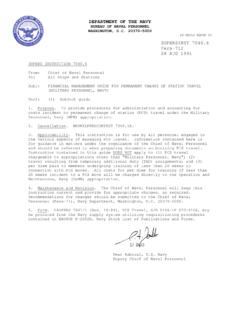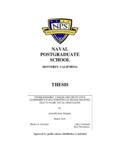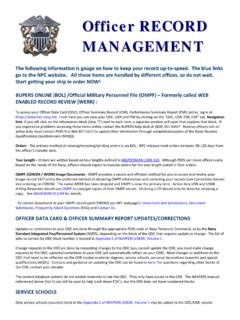Transcription of NAVAL POSTGRADUATE SCHOOL
1 NAVAL POSTGRADUATE SCHOOL MONTEREY, CALIFORNIA THESIS Approved for public release; distribution is unlimited. COMPARISON OF THE navy WORKING CAPITAL FUND AND MISSION FUNDING AS APPLIED TO navy SHIPYARDS by Andrew M. Cain June 2006 Thesis Co-Advisors: Jerry L. McCaffery John E. Mutty THIS PAGE INTENTIONALLY LEFT BLANK i REPORT DOCUMENTATION PAGE Form Approved OMB No. 0704-0188 Public reporting burden for this collection of information is estimated to average 1 hour per response, including the time for reviewing instruction, searching existing data sources, gathering and maintaining the data needed, and completing and reviewing the collection of information. Send comments regarding this burden estimate or any other aspect of this collection of information, including suggestions for reducing this burden, to Washington headquarters Services, Directorate for Information Operations and Reports, 1215 Jefferson Davis Highway, Suite 1204, Arlington, VA 22202-4302, and to the Office of Management and Budget, Paperwork Reduction Project (0704-0188) Washington DC 20503.
2 1. AGENCY USE ONLY (Leave blank) 2. REPORT DATE June 2006 3. REPORT TYPE AND DATES COVERED Master s Thesis 4. TITLE AND SUBTITLE Comparison of the navy Working Capital Fund and Mission Funding as Applied to navy Shipyards 6. AUTHOR(S) Andrew M. Cain 5. FUNDING NUMBERS 7. PERFORMING ORGANIZATION NAME(S) AND ADDRESS(ES) NAVAL POSTGRADUATE SCHOOL Monterey, CA 93943-5000 8. PERFORMING ORGANIZATION REPORT NUMBER 9. SPONSORING /MONITORING AGENCY NAME(S) AND ADDRESS(ES) N/A 10. SPONSORING/MONITORING AGENCY REPORT NUMBER 11. SUPPLEMENTARY NOTES The views expressed in this thesis are those of the author and do not reflect the official policy or position of the Department of Defense or the Government. 12a. DISTRIBUTION / AVAILABILITY STATEMENT Approved for public release: distribution is unlimited 12b.
3 DISTRIBUTION CODE A 13. ABSTRACT (maximum 200 words) The dramatic political and economic events, both globally and within the United States, during the early 1990s led to significant changes to the navy shipyard organizational structure. As part of the navy maintenance regionalization and consolidation program, the financial management system used to manage these commands has been changed. Specifically, the navy has shifted two of its four shipyards, with authorization to shift the other two in FY07, from the navy Working Capital Fund to mission funding through direct congressional appropriations. This funding shift has raised questions about the advantages and disadvantages each financial system provides shipyards, the operating differences that occur due to the funding change, and the future financial consequences of funding navy shipyards using direct appropriations.
4 This thesis identifies the advantages and disadvantages of the navy Working Capital Fund and the mission funding model in the context of a navy shipyard environment and determines whether the change in financial structure provides an overall benefit that should be pursued for all shipyards. 15. NUMBER OF PAGES 77 14. SUBJECT TERMS navy Working Capital Fund, Mission Funding, Direct Appropriations, Depot Maintenance, Intermediate Maintenance, navy Shipyards 16. PRICE CODE 17. SECURITY CLASSIFICATION OF REPORT Unclassified 18. SECURITY CLASSIFICATION OF THIS PAGE Unclassified 19. SECURITY CLASSIFICATION OF ABSTRACT Unclassified 20. LIMITATION OF ABSTRACT UL NSN 7540-01-280-5500 Standard Form 298 (Rev. 2-89) Prescribed by ANSI Std. 239-18 ii THIS PAGE INTENTIONALLY LEFT BLANK iiiApproved for public release; distribution is unlimited COMPARISON OF THE navy WORKING CAPITAL FUND AND MISSION FUNDING AS APPLIED TO navy SHIPYARDS Andrew M.
5 Cain Lieutenant, United States navy , Rose-Hulman Institute of Technology, 1999 Submitted in partial fulfillment of the requirements for the degree of MASTER OF BUSINESS ADMINISTRATION from the NAVAL POSTGRADUATE SCHOOL June 2006 Author: Andrew M. Cain Approved by: Jerry L. McCaffery Co-Advisor John E. Mutty Co-Advisor Robert N. Beck Dean, Graduate SCHOOL of Business and Public Policy iv THIS PAGE INTENTIONALLY LEFT BLANK vABSTRACT The dramatic political and economic events, both globally and within the United States, during the early 1990s led to significant changes to the navy shipyard organizational structure. As part of the navy maintenance regionalization and consolidation program, the financial management system used to manage these commands has been changed.
6 Specifically, the navy has shifted two of its four shipyards, with authorization to shift the other two in fiscal year 2007, from the navy Working Capital Fund to mission funding through direct congressional appropriations. This funding shift has raised questions about the advantages and disadvantages each financial system provides shipyards, the operating differences that occur due to the funding change, and the future financial consequences of funding navy shipyards using direct appropriations. This thesis identifies the advantages and disadvantages of the navy Working Capital Fund and the mission funding model in the context of a navy shipyard environment and determines whether the change in financial structure provides an overall benefit that should be pursued for all shipyards.
7 Vi THIS PAGE INTENTIONALLY LEFT BLANK viiTABLE OF CONTENTS I. A. OBJECTIVES ..1 B. SCOPE ..2 C. METHODOLOGY ..2 D. ORGANIZATION ..3 II. BACKGROUND ..5 A. DEPARTMENT OF THE navy MAINTENANCE ORGANIZATION ..5 1. Maintenance Echelons ..6 a. Organizational-Level b. Intermediate-Level Maintenance ..7 c. Depot-Level 2. Maintenance Policy and Procedures ..9 a. Preventative Maintenance ..10 b. Corrective B. navy MAINTENANCE C. CHANGE III. MISSION A. ORIGINS OF DIRECT APPROPRIATIONS ..17 B. CONGRESSIONAL BUDGET PROCESS ..18 1. Authorization and Appropriation ..19 2. Congressional Appropriations Subdivisions ..20 C. DEFENSE BUDGET PREPARATION ..21 D. DIRECT APPROPRIATION RESTRICTIONS ..25 1. Purpose Restrictions.
8 25 2. Time Period Restrictions ..26 3. Obligation Amount Restrictions ..27 E. BUDGET EXECUTION FOR MISSION FUNDED ORGANIZATIONS ..28 F. INTERMEDIATE MAINTENANCE FACILITY OPERATIONS ..29 IV. navy WORKING CAPITAL FUND ..31 A. THE FORMATION OF THE B. NWCF OBJECTIVES ..32 C. NWCF OPERATION ..34 1. Cost Accounting for the a. Full Cost Recovery ..36 D. NWCF BUDGET PROCESS ..36 E. NWCF MANAGEMENT ..38 F. WORKING CAPITAL FUND 1. Cash Management Restrictions ..39 2. Efficiency viiiV. MISSION FUNDING VS. WORKING CAPITAL FUNDING ..41 A. PUGET SOUND PROTOTYPE ..43 B. PROBLEMS WITH USING SHIPYARD DATA ..44 C. ANALYSIS OF OPERATIONAL AND FINANCIAL FLEXIBILITY ..45 1. Personnel Flexibility ..45 a. Personnel b. Workforce 2. Financial Flexibility ..46 a. Fiscal Year b.
9 Maintenance Costs Exceed Appropriations ..47 3. Decision Making Authority ..48 D. ANALYSIS OF COST 1. Customer/ Provider Relationship ..49 2. Private Business Practices ..50 a. Cost Accounting ..50 b. Depreciation Expense ..51 3. Cost Visibility for Senior VI. CONCLUSIONS ..53 A. COST VISIBILITY ..53 1. Cost Reporting ..53 2. Business Practices ..55 B. OPERATIONAL AND FINANCIAL FLEXIBILITY ..55 1. Operational 2. Financial Flexibility ..56 C. FINAL RESULTS ..57 D. RECOMMENDATIONS FOR FURTHER STUDY ..58 1. NAVAL Aviation Depots ..58 2. East Coast Shipyard Funding Shifts ..58 3. One LIST OF REFERENCES ..59 INITIAL DISTRIBUTION LIST ..63 ixLIST OF FIGURES Figure 1. Congressional Budget Functions ..19 Figure 2. 2006 Defense Appropriations Act Figure 3. DoD Budget Preparation Process for PHNS & Figure 4.
10 Mission Funding Budget Figure 5. MF vs. NWCF Organizational Relationships ..33 Figure 6. Unit Cost Figure 7. NWCF Budget/ Rate Setting Process ..37 x THIS PAGE INTENTIONALLY LEFT BLANK xiLIST OF ACRONYMS 3M Maintenance and Material Management 2M Miniature and Micro-Miniature APN Aircraft Procurement navy ABC Activity Based Costing AOR Accumulated Operating Result AOB Annual Operating Budget ASN (FM&C) Assistant Secretary of the navy (Financial Management and Comptroller)














